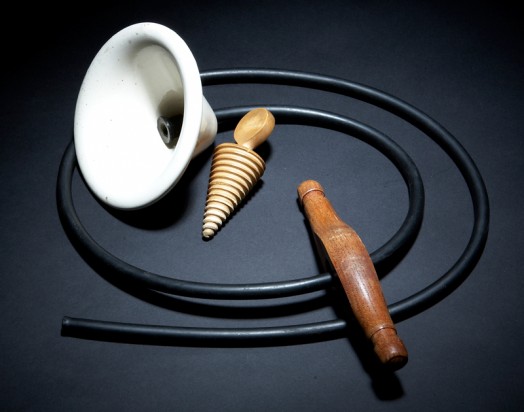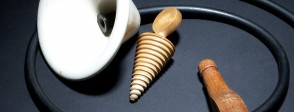
Lady Constance Lytton
This force-feeding equipment was used at Walton Gaol when the suffragette, Lady Constance Lytton, was imprisoned there. Lytton wrote about the horror of force-feeding in an account of her suffragette experiences, published in 1914. During earlier periods of imprisonment in London and Newcastle, Lytton had suspected that working-class suffragettes were treated more harshly than upper-class women like herself. She decided to test the existence of class differences in the treatment of suffragettes by assuming the dress and name of a working woman, Jane Warton. She was arrested at a demonstration in Liverpool and was imprisoned in Walton Gaol. She began a hunger strike, and, after four days, was fed by force.
At around six o’clock in the evening on 18 January 1910, the Senior Medical Officer of the prison and five wardresses (female prison officers) entered Lytton’s cell. They told her to lie on the plank bed. Two wardresses held her arms, one held her head and another held her feet; the fifth helped the doctor to pour the food. Lytton clenched her teeth tightly together, but the doctor forced them apart with a steel implement and fixed a steel gag in her mouth, opening the gag to force her jaws wide apart. He then inserted a four foot tube down Lytton’s throat and quickly poured in the liquid food. Lytton was instantly sick, but the wardress forced back her head and the force-feeding continued. As she later wrote: “The horror of it was more than I can describe”. Lytton continued her hunger strike and endured another seven force-feedings before her release from Walton Gaol at the end of January. She never really recovered from her ordeal, suffered a stroke in 1912, and died in 1923.
The force-feeding of suffragettes after 1909
From 1905 until the outbreak of World War I, about 1000 suffragettes were sent to prison for taking part in militant action as part of their campaign for women’s right to vote. Imprisoned suffragettes argued that they should be given the status of political prisoners and placed in the First Division of the prison system. This would have given them certain privileges such as more frequent visits and the freedom to write books and articles. The government refused their demand, and, from 1909, the imprisoned suffragettes began to use huger-strikes in protest. The prison authorities, anxious to avoid the deaths of suffragettes in custody, began the practice of force-feeding the hunger-striking women through a tube. Force-feeding was a brutal procedure that caused intense pain and could endanger the women’s health. Emmeline Pankhurst, who had founded the WSUP (Women’s Social and Political Union) in 1903, and who went on hunger-strike in Holloway Gaol, London, was horrified by the screams of the women during force-feeding. In her autobiography, she wrote: “Holloway became a place of horror and torment. Sickening scenes of violence took place almost every hour of the day, as the doctors went from cell to cell performing their hideous office”.
Many people in Britain felt that the force-feeding of suffragettes was an outrage and the method caused great controversy. In April 1913, the government stopped the use of force-feeding and introduced the Prisoners’ Temporary Discharge of Ill Health Act. As soon as hunger-striking suffragettes became ill, they were released from prison; when they recovered, they were re-arrested and returned to prison to complete their sentences. This so-called ‘Cat and Mouse Act’ meant that many women served extended sentences and it prolonged the period of force-feeding. Some imprisoned suffragettes were force fed more than 200 times. Force-feeding was stopped at the outbreak of the World War I when the WSUP called a temporary suspension of militant action and the government granted an amnesty to all imprisoned suffragettes.
The force-feeding of conscientious objectors during World War I
Before World War I there had never been compulsory military service in Britain, but the high loss of life in the first years of the war changed this situation. In March 1916, the government introduced the Military Conscription Act which made military service compulsory for all single men in England Scotland and Wales with four categories of exemption. There were around 16,000 conscientious objectors during the First World War. Most of these men did alternative civilian jobs to help the war effort or worked as stretcher-bearers in the army. However, around 980 ‘absolutists’ refused to do any war-related work and were imprisoned for the duration of the war. They were given the most severe level of prison sentence available at the time and were forced to endure periods of solitary confinement and hard labour. Conscientious objectors were not released from prison until about six months after the end of the war, in order to give returning soldiers a head-start when looking for jobs. In protest, some conscientious objectors went on hunger strike and were force-fed by the prison authorities.
More information
Lady Constance Lytton’s account of force-feeding at Walton Gaol, Liverpool
http://digital.library.upenn.edu/women/lytton/prisons/prisons.html#XIII
An article on the force-feeding of suffragettes by June Purvis
http://www.timeshighereducation.co.uk/93438.article
Votes for women
A short documentary for Timelines TV.
http://www.timelines.tv/index.php?t=1&e=16
Radio interviews
Collection of radio interviews featuring women recalling their struggle to win the vote from the BBC archive.
http://www.bbc.co.uk/archive/suffragettes/
The Legacy of the Suffragettes
BBC radio programmes to mark the 100th anniversary of the founding of the suffragettes in 1903.
http://news.bbc.co.uk/1/hi/programmes/the_westminster_hour/3163132.stm
The campaign for female suffrage
Historical background and sources from the British Library
http://www.bl.uk/learning/histcitizen/21cc/struggle/suffrage/suffrageintro.html
Cats and mice
Documents from the National Archives
http://www.nationalarchives.gov.uk/education/resources/cats-and-mice/
A collection of sources on the suffragettes from the National Archives
http://www.nationalarchives.gov.uk/education/britain1906to1918/g4/cs1/g4cs1.htm
International Museum of Women
http://www.imow.org/exhibitions/women-power-and-politics/voting
BBC World War One at Home: Conscientious Objectors
http://www.bbc.co.uk/programmes/p01xl7mk
Conscientious objectors in their own words
Imperial War Museum resource
http://www.iwm.org.uk/history/conscientious-objectors-in-their-own-words
More information
-
Lady Constance Lytton’s account of force-feeding at Walton Gaol, Liverpool
Source: upenn.edu
-
An article on the force-feeding of suffragettes by June Purvis
Source: timeshighereducation.co.uk
-
Votes for women
A short documentary for Timelines TV.
Source: timelines.tv
-
Radio interviews
Collection of radio interviews featuring women recalling their struggle to win the vote from the BBC archive.
Source: bbc.co.uk
-
The Legacy of the Suffragettes
BBC radio programmes to mark the 100th anniversary of the founding of the suffragettes in 1903.
Source: bbc.co.uk
-
The campaign for female suffrage
Historical background and sources from the British Library
Source: bl.uk
-
Cats and mice
Documents from the National Archives
Source: nationalarchives.gov.uk
-
A collection of sources on the suffragettes from the National Archives
Source: nationalarchives.gov.uk
-
International Museum of Women
Source: imow.org
-
BBC World War One at Home: Conscientious Objectors
Source: bbc.co.uk
-
Conscientious objectors in their own words
Imperial War Museum resource
Source: iwm.org.uk


